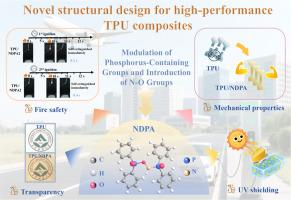一种新型含磷氮氧化物,用于提高热塑性聚氨酯的防火安全性和紫外线屏蔽性能
IF 7.4
2区 化学
Q1 POLYMER SCIENCE
引用次数: 0
摘要
新兴领域的快速发展对阻燃型热塑性聚氨酯(TPU)的综合性能提出了更严格的要求。传统的磷氮阻燃剂需要高负荷才能在TPU中实现阻燃,导致TPU复合材料的力学性能和耐老化性能显著降低。本研究通过在磷氮阻燃结构中引入具有气相自由基捕获能力的NO,同时调节P-C和P-O,成功合成了含有多个阻燃基团的新型阻燃剂N-((二苯基磷酰基)氧)- p, p -二苯基膦酰胺(NDPA)。仅2 wt% NDPA就能使TPU达到UL-94 V-0额定值,极限氧指数(LOI)上升到30.1%。阻燃机理分析表明,NDPA在气相中发挥了优异的自由基猝灭作用,促进了TPU复合材料中膨胀的优质屏蔽炭层的形成,显著提高了TPU复合材料的阻燃性。因此,与纯TPU相比,TPU/NDPA2复合材料的峰值放热率和总放热率分别降低了49.7%和28.1%。同时,由于NDPA在TPU基体中的良好相容性和均匀分散,TPU/NDPA复合材料保持了原有的透明度和力学性能。此外,NDPA的共轭芳族结构使TPU复合材料具有优异的紫外线屏蔽性能。本研究表明,合成的TPU/NDPA复合材料在阻燃性、透明度、防紫外线和力学性能方面达到了最佳平衡,为高性能TPU复合材料的设计提供了一种创新方案。本文章由计算机程序翻译,如有差异,请以英文原文为准。

A novel phosphorus-containing nitrogen oxide for enhancing fire safety and UV shielding properties of thermoplastic polyurethanes
The rapid development of emerging fields has put forward stricter requirements for the comprehensive properties of flame retardant thermoplastic polyurethane (TPU). Traditional phosphorus-nitrogen flame retardants needed high loading levels to achieve flame retardancy in TPU, resulting in significantly reduced mechanical performance and aging resistance of TPU composites. In this study, a novel flame retardant N-((diphenylphosphoryl)oxy)-P, P-diphenylphosphinic amide (NDPA), containing multiple flame retardant groups was successfully synthesized by introducing N![]() O endowed with gas phase radical trapping capability while regulating P-C and P-O within a phosphorus-nitrogen flame retardant structure. Merely 2 wt% NDPA enabled TPU to achieve the UL-94 V-0 rating, with the limiting oxygen index (LOI) rising to 30.1 %. The flame retardant mechanism analysis showed that NDPA played an excellent free radical quenching effect in gas phase, and promoted the formation of expanded and high-quality shielding char layers in TPU composites, which significantly improved the flame retardancy of TPU composites. Therefore, the peak heat release rate and total heat release of TPU/NDPA2 composites were decreased by 49.7 % and 28.1 % compared with pure TPU. Meanwhile, due to the good compatibility and uniform dispersion of NDPA in the TPU matrix, the TPU/NDPA composites retained their original transparency and mechanical properties. Additionally, the conjugated aromatic structure of NDPA bestowed TPU composites with excellent UV shielding performance. This study demonstrated that the synthesized TPU/NDPA composites achieved the optimal balance of flame retardancy, transparency, UV shielding, and mechanical properties, providing an innovative scheme for the design of high-performance TPU composites.
O endowed with gas phase radical trapping capability while regulating P-C and P-O within a phosphorus-nitrogen flame retardant structure. Merely 2 wt% NDPA enabled TPU to achieve the UL-94 V-0 rating, with the limiting oxygen index (LOI) rising to 30.1 %. The flame retardant mechanism analysis showed that NDPA played an excellent free radical quenching effect in gas phase, and promoted the formation of expanded and high-quality shielding char layers in TPU composites, which significantly improved the flame retardancy of TPU composites. Therefore, the peak heat release rate and total heat release of TPU/NDPA2 composites were decreased by 49.7 % and 28.1 % compared with pure TPU. Meanwhile, due to the good compatibility and uniform dispersion of NDPA in the TPU matrix, the TPU/NDPA composites retained their original transparency and mechanical properties. Additionally, the conjugated aromatic structure of NDPA bestowed TPU composites with excellent UV shielding performance. This study demonstrated that the synthesized TPU/NDPA composites achieved the optimal balance of flame retardancy, transparency, UV shielding, and mechanical properties, providing an innovative scheme for the design of high-performance TPU composites.
求助全文
通过发布文献求助,成功后即可免费获取论文全文。
去求助
来源期刊

Polymer Degradation and Stability
化学-高分子科学
CiteScore
10.10
自引率
10.20%
发文量
325
审稿时长
23 days
期刊介绍:
Polymer Degradation and Stability deals with the degradation reactions and their control which are a major preoccupation of practitioners of the many and diverse aspects of modern polymer technology.
Deteriorative reactions occur during processing, when polymers are subjected to heat, oxygen and mechanical stress, and during the useful life of the materials when oxygen and sunlight are the most important degradative agencies. In more specialised applications, degradation may be induced by high energy radiation, ozone, atmospheric pollutants, mechanical stress, biological action, hydrolysis and many other influences. The mechanisms of these reactions and stabilisation processes must be understood if the technology and application of polymers are to continue to advance. The reporting of investigations of this kind is therefore a major function of this journal.
However there are also new developments in polymer technology in which degradation processes find positive applications. For example, photodegradable plastics are now available, the recycling of polymeric products will become increasingly important, degradation and combustion studies are involved in the definition of the fire hazards which are associated with polymeric materials and the microelectronics industry is vitally dependent upon polymer degradation in the manufacture of its circuitry. Polymer properties may also be improved by processes like curing and grafting, the chemistry of which can be closely related to that which causes physical deterioration in other circumstances.
 求助内容:
求助内容: 应助结果提醒方式:
应助结果提醒方式:


